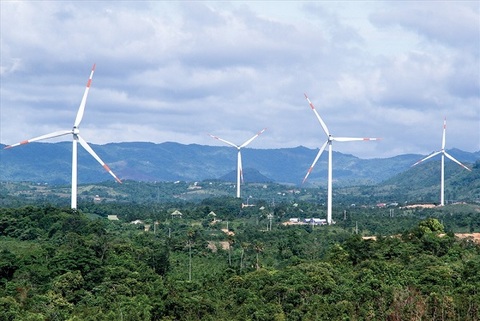|
Heat, which is an inexhaustible source of energy, has attracted multiple local and foreign investors. Heat attracts investors Vietnam has a tropical climate remarkably influenced by monsoon and is located entirely within the tropical belt of the northern hemisphere, more inclined to the tropics than the equator. The location makes Vietnam have a high temperature, ranging from 22 to 27 degrees Celsius. There are some 100 rainy days a year with average rainfall of 1,500 to 2,000 millimeters. Air humidity is about 80%. The number of sunny hours is some 1,500 to 2,000 hours per year and the average annual radiation is 100 kilocalories per square centimeter. The abundant source of heat, good energy prices and preferential policies have attracted foreign investors in solar power projects. In the past two years, the local market witnessed the mushrooming of solar power projects. According to statistics from the Electricity and Renewable Energy Department under the Ministry of Industry and Trade, as of mid-2018, 10 solar power projects, with a total registered capacity of 4.7 gigawatts in 2020 and 1,770 gigawatts in the following years, had been added to the national and provincial power development plans. In addition, investors have registered to develop 748 rooftop solar power projects with a combined capacity of 11.55 megawatts.
However, not all foreign investors are patient to complete investment procedures, so they acquire solar power projects from domestic firms for operation. According to the Ministry of Industry and Trade, this is a normal trend. Foreign investors are also interested in solar power projects due to the attractive feed-in-tariff (FIT) policy although the FIT of solar power has been cut to 7.09 U.S. cents per kilowatt hour from the previous 9.35 U.S. cents. Most coal- and gas-fired power projects conducted under the build-operate-transfer model are required to be guaranteed by the Government, but the requirement is not applied to solar and wind power projects, which is attractive to investors, said head of the Electricity and Renewable Energy Department Hoang Tien Dung. He added that large power firms in the world do not directly develop projects to reduce risks, time and costs in the initial stages, including site clearance and application for the approval from local authorities.
Investment disguise As of May, 92 solar power projects and 10 wind power projects, with a total capacity of nearly 6,000 megawatts, have been put into commercial operation. Leader of a large power firm in the south said large shareholders of its partner are from countries which want to expand their territories. Possibly these shareholders are carrying out their national duties under the direction of their governments, while many solar power projects are located in strategic military positions. Loopholes in policies have led to group interest in solar power projects. Few local investors manage solar power projects in reality. After completing procedures, local investors often transfer projects to foreign partners for a profit. Meanwhile, genuine investors find it hard to complete administrative procedures and secure capital for project development. National Assembly Deputy Truong Trong Nghia related how Minister of Environment and Natural Resources Tran Hong Ha has been questioned over the situation of foreigners have used local firms as fronts to acquire land lots in sensitive areas. Many foreign investors do not invest directly in land. They later buy shares in Vietnamese firms that are entitled to land lots. If they take control of the firms, they will operate projects and thus the land. Therefore, the Government must issue policies to protect local investors, Nghia added. SGT |
||||

Vietnam’s wind sector to see growing opportunities
Experts forecast Vietnam’s wind power sector would further grow in line with the Government’s stronger regulatory support announced recently and rising investor interest, which has strengthened the project pipeline.

Ha Tinh approves $695 million wind power plant
The People's Committee of the central province of Ha Tinh has approved a wind power project with a total investment of VND16.2 trillion (US$695.3 million).

